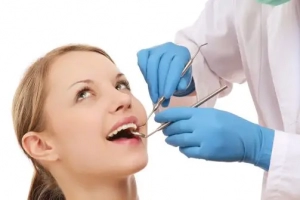Oral Cancer Exam from Green Dental & Orthodontics
More than 7,000 people each year die because they didn’t get oral cancer treatments. But that’s not the only tragedy — more than 7,000 individuals are diagnosed with oral cancer each year and either die or are afflicted with a second disease as a result.
Oral cancer is easily diagnosed with an annual oral cancer exam, which can also effectively treat the disease when caught in its earliest stages.
In the past decade, there’s been an increase in oral cancer incidence, not just of this form but other forms of cancer as well, on average by about 2.1% per year. This is partly due to the increased use of tobacco and alcohol, with smoking and alcohol abuse contributing to nearly three-quarters of all cases.

Reasons for Oral Cancer Exam
This new era is the perfect time to get serious about oral hygiene. Oral cancer has three stages: an asymptomatic stage, a warning stage, and an appearance stage.
Dentists are the ones best qualified to examine all types of oral cancers during an examination, so have your dentist give you a routine examination.
Oral cancers can be of varied histologic types such as teratoma, adenocarcinoma, and melanoma.
The most common type of oral cancer is malignant squamous cell carcinoma. This oral cancer type usually originates in lip and mouth tissues.
There are many different places in the oral cavity and maxillofacial region in which oral cancers commonly occur, including:
- Lips
- Mouth
- Tongue
- Salivary Glands
- Oropharyngeal Region (throat)
- Gums
- Face
More Reasons for Oral Cancer Examinations
Decrease your risk of oral cancer with some lifestyle changes. It is important to know that around 75% of cancers are linked with behaviors such as smoking, tobacco use, and alcohol consumption. Your dentist can provide you with the information and education needed for making lifestyle changes and kicking the habit.
When oral cancer is diagnosed in its earliest stages, treatment is generally very effective.
In this new era, it’s more important than ever to be aware of any abnormalities that you may find on your tongue, gums, or mouth. In order to do so, one should see a dentist as quickly as possible.
A dental examination can be a lengthy process. Oral cancer examinations are one of the parts of the exam when the dentist and dental hygienist will look into different maxillofacial regions to determine if any changes are occurring.
The following signs will be investigated during a routine oral cancer exam:
- Red patches and sores– Red patches on the floor of the mouth, the front and sides of the tongue, white or pink patches which fail to heal, and slow healing sores that bleed easily.
- Leukoplakia– This is a hardened white or gray, a slightly raised lesion that can appear anywhere inside the mouth. Leukoplakia can be cancerous or may become cancerous if treatment is not sought.
- Lumps– Soreness, lumps or the general thickening of tissue anywhere in the throat or mouth can signal pathological problems.
Oral Cancer Exams, Diagnosis & Treatment
An oral cancer examination is painless and easy. During the visual part of the examination, your dentist will visually explore the body for abnormalities and feel the face, neck, and glands for anything that feels unusual. The doctor will then look for any tissue that looks abnormal beneath the tongue or surface of the mouth.
Lasers can highlight pathologic changes in the mouth, making them easier to see. This is particularly helpful for oral cancer checks. The laser can “look” below the surface of the oral cavity for abnormalities that would be invisible to the naked eye.
If there are any abnormalities, spots, lumps, or lesions on the enamel of teeth, the dentist will take a diagnostic impression and implement a procedure.
In the event that the initial treatment plan is ineffective, a biopsy of the area will be performed. The biopsy includes a clinical evaluation which will identify the precise stage and grade of the oral lesion.
Oral cancer is deemed to be present when the basement membrane of the epithelium has been broken. This breaks the separation between the cells, and allows for cancerous cells to move through and complete metastases in other places in the mouth and jaw. It’s also possible that treatment methods will vary according to a more precise diagnosis, but this can include removal of the cancer cells, radiation therapy, and chemotherapy.
Dentists recommend that comprehensive oral screenings should be done at least once a year. However, typically the dentist and hygienist only look for changes or lesions in the mouth during bi-annual check-ups. These are good indicators of cancer, but if you’re not looking at the whole mouth, it’s hard to treat any other potential symptoms.
If you have any questions or concerns about oral cancer, please contact our practice.
